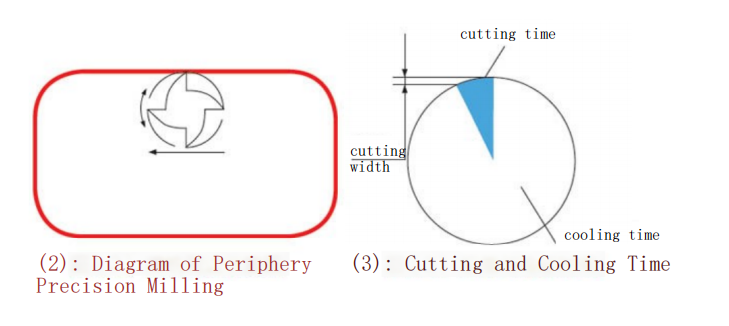
Machining Performance of Titanium Alloy
Titanium alloy has excellent mechanical properties, strong corrosion resistance, and low density. However, during machining, titanium alloy exhibits poor cutting performance, mainly manifested in the following aspects:
(1) High cutting force: Titanium alloy materials have high strength, resulting in large cutting resistance during machining, leading to the generation of a large amount of cutting heat.
(2) Low thermal conductivity: Titanium alloy has low thermal diffusivity, resulting in the concentration of a large amount of cutting heat in the cutting area.
(3) High tool tip stress: Titanium alloy has low plasticity, and the chips generated during processing are prone to bending, leading to a short contact length between the chips and the rake face, thereby increasing the unit area force on the cutting edge and causing stress concentration at the tool tip.
(4) High frictional force: Titanium alloy has a small elastic modulus, resulting in increased friction between the front and rear faces of the tool.
(5) High chemical reactivity: Titanium elements can easily react with gases such as hydrogen, oxygen, and nitrogen in the air at high cutting temperatures, forming a hard surface layer and accelerating tool wear.
Efficient Machining Equipment for Titanium Alloy
To meet the requirements of efficient machining of titanium alloy components, new types of titanium alloy machining equipment exhibit the following trends:
(1) High torque: Titanium alloy has high strength, and the cutting force during machining is extremely high. An obvious feature of titanium alloy machining equipment is the large spindle torque and swivel torque.
(2) Application of electric spindles: High-power, high-torque electric spindles have been applied in titanium alloy machining.
(3) Horizontal machining centers for titanium alloy machining: Horizontal machining centers are convenient for chip removal, conducive to improving machining efficiency and quality, and interchangeable worktables facilitate multi-position machining and assembly of flexible production lines, increasing equipment utilization.
(4) High-pressure internal cooling: In titanium alloy machining, cutting heat is concentrated at the tool tip, which can easily cause tool wear or damage. High-pressure internal cooling can accurately spray into the cutting area to take away cutting heat.
Efficient Machining Tools for Titanium Alloy
Titanium alloy has poor cutting performance, and the cutting speed in traditional machining methods generally does not exceed 60m/min. Rough machining of titanium alloy mainly relies on large cutting depths, low speeds, and low feeds to achieve maximum metal removal rates. Precision machining uses PVD-coated cemented carbide tools for high-speed milling with small cutting widths and large cutting depths to achieve efficient cutting. Therefore, improvements in titanium alloy machining tools mainly focus on how to avoid vibration, reduce cutting forces, and lower cutting temperatures during high-force cutting.
Efficient Machining Tool Techniques for Titanium Alloy
(1)Face milling of titanium alloy: When face milling titanium alloy parts, efficient machining is achieved by using a small cutting depth and large feed. The principle of high feed milling is to reduce the main cutting edge angle of the tool so that the tool can maintain a small chip thickness even at very high feed rates, thereby reducing cutting forces at high feeds and achieving a large feed rate at low cutting speeds, increasing the metal removal rate per unit cutting depth. At the same time, part of the cutting force is vertical upward, and the tangential force is small, requiring low machine power and rigidity, making this method widely applicable.
(2) Groove machining of titanium alloy: Grooves are a major feature of titanium alloy aerospace components, with high material removal rates and large workloads. Therefore, groove machining is the key to achieving efficient machining of titanium alloy parts. Powerful cutting with large cutting depths, low speeds, and low feeds to achieve maximum metal removal rates is an effective method for rough machining titanium alloy. Currently, the most efficient tool for rough machining titanium alloy is the corn cutter.

(3) Fillet machining technology: To reduce aircraft weight, fillet radii of aircraft structural components are usually small, requiring the use of small diameter milling cutters for machining. Due to the sudden change in cutting volume at fillet radii, the cutting force varies greatly. Under sudden changes in cutting force, the tool is prone to vibration, and even tool edge failure, resulting in severe tool wear and low machining efficiency. Plunge milling is the best way to solve efficiency issues in fillet machining. Plunge milling produces less vibration than conventional milling, and the toolpath for removing fillet radius allowances is efficient. By using plunge milling cutters of different diameters for fillet machining, most of the fillet radius allowances can be removed. Then, use an end mill to remove the remaining residue from the plunge milling, which can significantly improve machining efficiency.
(4) Precision side milling technology: When machining the sidewalls, utilize the intermittence of milling to achieve high-speed cutting to improve surface quality and machining efficiency. When machining the sidewalls, due to the small cutting width, the cutting time for each tooth per revolution is short, resulting in a long cooling time. With sufficient cooling, the cutting temperature can be effectively controlled, allowing for significantly increased cutting speeds to improve machining efficiency. The use of PVD-coated solid carbide end mills or ultra-fine toothed cemented carbide end mills for high-speed finishing machining of titanium alloy can greatly improve machining efficiency and accuracy.

(5) Simulation optimization technology: The cutting allowance for titanium alloy structural parts changes continuously during rough machining. The NC programs compiled by current CAM software often only set fixed cutting parameters. To prevent local programs from causing impacts on tools and machine tools due to excessive cutting allowances, the usual method is to reduce the overall cutting parameters to ensure tool life and part quality, resulting in extremely low machining efficiency. Vericut’s simulation optimization technology can solve this problem well. By setting up a cutting parameter optimization library in Vericut software and simulating it, the cutting parameters in the program can be optimized based on the estimated cutting allowances and cutting conditions. This extends tool life, ensures part quality, and improves machining efficiency.
Meteeyou Cemented Carbide Co., Ltd. has the capability to provide high-quality ébauches en carbure, which leads to outstanding performance of cutting tools in processing aerospace-grade titanium alloys. We believe that our years of experience in carbide materials can be of great assistance to you.









